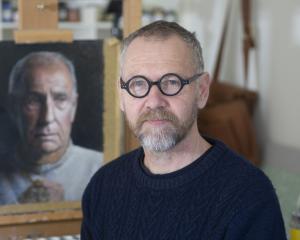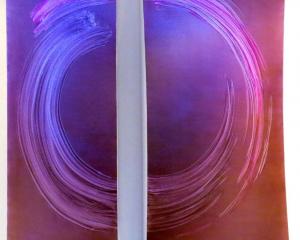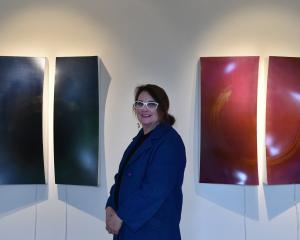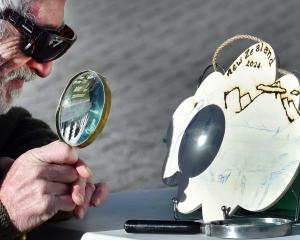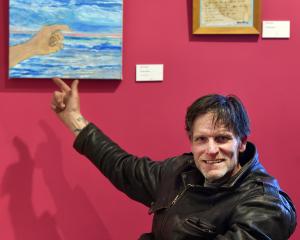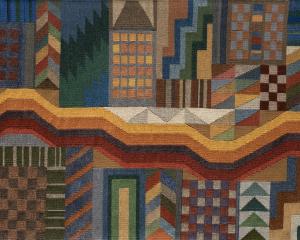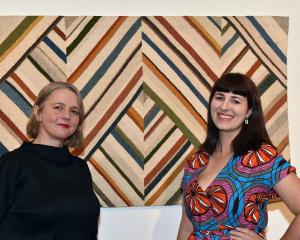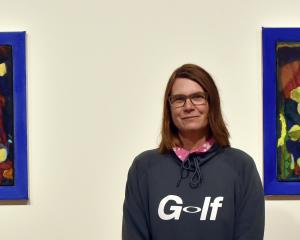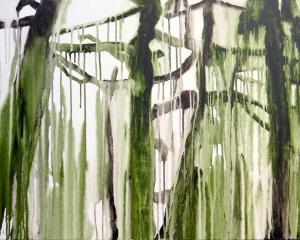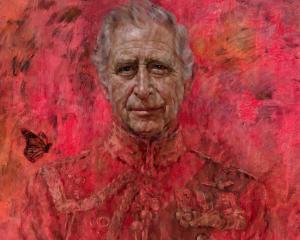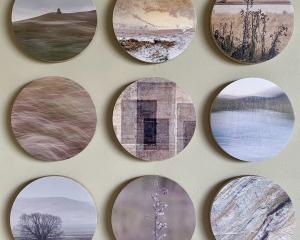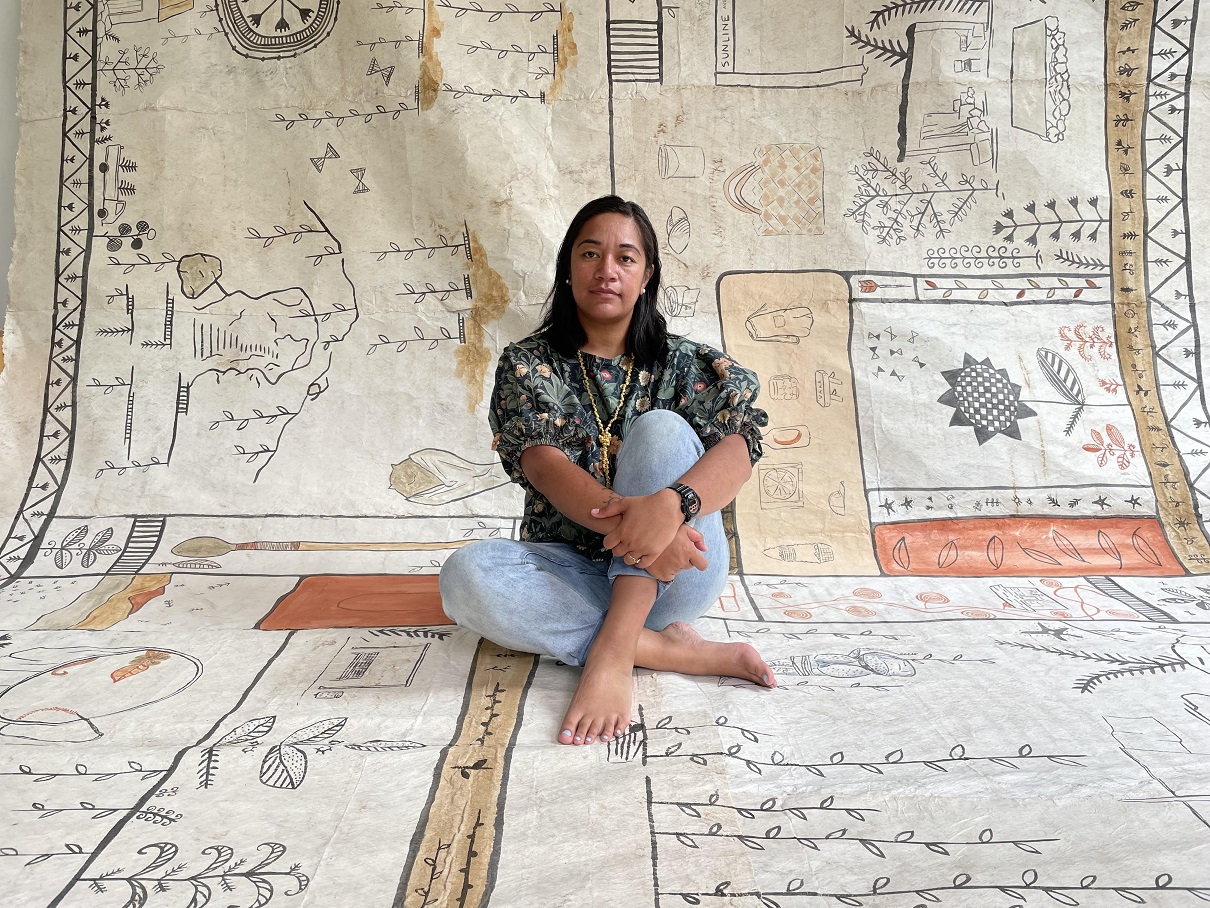
Up painting until nearly midnight in the cabin of an ocean ship, Cora-Allan Lafaiki Twiss spreads out her day’s paintings to dry on every flat space — even her bed.
The only clear surface left to sleep on is the couch, so she curls up on it for a few hours’ sleep.
She is on the Heritage Adventurer as it travels up New Zealand for two weeks visiting heritage sites explored by Captain James Cook on the Endeavour.
"I wanted to visit important sites to our narrative in Aotearoa."
Lafaiki Twiss (Ngāpuhi, Ngātitumutumu, Niue; Alofi, Liku) does not want to miss a moment of the experience, even if the sometimes rocky trip created some creative challenges.
"I enjoy working on a boat, I’d do it again in a heartbeat."
The enjoyment of working on the water is something Lafaiki Twiss only recently discovered. In 2021 she was selected for the Parehuia residency in Titirangi, Auckland, hosted by the McCahon House Trust.
She decided, like McCahon, to take her studio to the water. So she bought a little boat and got her skipper’s licence.
"The experience of being a boatie, I’m absolutely addicted to," she says.
"I feel like I’m not 100% safe at sea because you have to really understand the elements, the weather, what you are doing, but I still have a sense of peace, a sense of unknowing, a sense of exploration."
Her next trip, travelling up New Zealand’s coast, was "way more" than she could have expected as it has led to a first for the artist — being able to combine elements of both her Māori and Niuean whakapapa — using traditional hiapo (decorated bark cloth) from Niue and Māori painting techniques using pigments from the whenua in her exhibition "Encountering Aotearoa".
"They have been able to collide in this show, meet in one space. The show itself heavily features the whenua, the landscape. It has been a real exploration for myself of what it means to be Māori and Niuean from Pacific, to create and look at whenua, the place I live in, the way of experiencing it differently through this continuous trip around the coastline."
She travelled from south to north following in the footsteps of the botanists and artists on board the Endeavour during its maiden voyage in 1769, in particular Tupaia, a Tahitian navigator on the boat who had with him on the trip a young family member, Taiata.
In an echo of this, Lafaiki Twiss asked along her father, who is Niuean, as her assistant. The pair are very close and her father often joins the family on arts residencies and research projects.
"Having my dad there to accompany me but also to get his perspective of the trip was really interesting. He doesn’t come from an arts background but the knowledge of his generation living in Aotearoa allowed him to experience it differently.
"It was really good to get a frame of reference from what he had learnt in school and what I had learnt."
As Lafaiki Twiss tends to work from 5am to midnight, having someone to make her a cup of tea or just be there means a lot.
"He’s a really good buddy to be honest. Just hearing his snoring in the corner is comforting. Working as an artist can be very isolating so having a whanau member on board makes it more whole."
It is also a reflection of the journey Lafaiki Twiss and her father have been on. Growing up in West Auckland with four siblings in a three-bedroom house, the emphasis was on earning enough to feed the family.
"I didn’t grow up in a household where art was a thing. For myself it was a very different world. My parents had never been to university — I was the first in my family to do so."
Lafaiki Twiss forged her own path to be an artist, getting a scholarship to AUT at 17, enrolling without her family’s knowledge. Over the years as her practice has grown and her work has sold, her father has come around.
"Now they’re really on board as they’re able to see the capacity of my dreams. My dad makes all my tools for my traditional hiapo practice and my sister is always there. We all kind of play roles, it’s not a singular practice, it’s one the whole family loves as they get to see one of us succeed."
Her father also created journals while on the boat, reflecting on the research he did on historical marine journals and the stories of mariners such as Sir Peter Blake.
While the history shared aboard was from a Pākehā perspective, Lafaiki Twiss and her father were able to add their knowledge to the mix.
"It helped embody the story a little bit more. It made me think about idea of the Pacific migration from then to where Māori are now and how culture, how things have changed and how art is being expressed."
She created some smaller works on the boat, of views from her window and of sites they visited. Her first attempt at using gold leaf as the boat rocked along in southern seas was not very successful.
" I’m just lucky I have good sea legs. I purely went to painting, I didn’t add any gold leaf after that. The shape of the window started to incorporate itself into my work. I could see these two lines cutting up the whenua so it has come into the works."
When she returned to land, she began work on what was to become a 17.4m-long work made up of 11 painted wooden panels. Named Ko Ao, Ko Ao, Ko Aotearoa! for the call of Kuramārōtini, the wife of Kupe, one of New Zealand’s first navigators, it is completely painted with clay from the whenua across the North and South islands.
"It’s made from processes that Māori would have been using for 100 years and showcases that. It is a celebration of it for myself and is one of show’s great achievements."
She has also used hiapo, but not in the way most people familiar with her work will expect. Her hiapo work has been credited with reigniting interest of the historical cultural practice in the Niuean community.
"A lot of the compositions are new for me — my work doesn’t look like what it usually looks like. I think people are going to be surprised purely because I’m looking at it from the perspective of encountering Aotearoa — it doesn’t feature any traditional Niuean motifs that my work is known for."
In these works she has used cyanotype, a photographic chemical process, on top of hiapo and exposed it to create a "photogram" of some of the sites they visited such as Luncheon Cove, where the first Pākehā built a house, and Dusky Sound.

"That is ...very new to my practice and something I wanted to push, using traditional materials and contemporary as well."
Some of the hiapo was also soaked in sea water at some of the places they visited.
"It’s almost like capturing the mauri [essence] from the moana. They work really nicely together."
Over the years, Lafaiki Twiss has built up a large library of colours, many of them from her own turangawaewae, where she whakapapas to such places as the Waikato and Bay of Islands, where her grandmother is buried.
"Being able to see the whenua of our tipuna from the water was a really amazing experiences for me and really rounded my thinking of the use of whenua."
In this show she has used 15 colours. Some are from people who have given them to her.
"I like the idea of using mostly colours from where I’m from or where I live mostly in respect to the iwi who live in those areas."
But some areas like Rotorua and Taupo have "beautiful" coloured clays in pinks and purples.
"I wish I had a lot of whakapapa around the country."
The Bay of Islands has a porcelain-type clay that makes a wonderful white pigment which she has used for the clouds in her large painting.
"It’s the first time I’ve used clouds in this work, so the white in particular acting as clouds, is really nice that it comes from just around the corner from where my grandmother is buried."
Making the pigments is a time intensive process that requires Lafaiki Twiss to harvest on a dry day so she can accurately assess the colour of the clay.
"When it is wet it is a completely different thing."
The clays are processed by sifting and grinding them down, sometimes for a very long time, to get it fine enough to use as paint. Then she adds a binder and water to the pigment. Traditionally the binder was anything from whale fat to shark oil or kauri gum. She uses kauri gum when she can access it, crushed down with water.
"It’s all very natural. As I’m able to collect the pigments myself it’s free and doesn’t cost a lot in regard to money, but it does cost a lot in regard to time and knowledge."
Using pigments in this way is a growing practice in New Zealand, and Lafaiki Twiss thinks her 17.4m work is probably one of the largest ever done in the pigments.
The size of the work also presented challenges for how it would be displayed.
Lafaiki Twiss, who trained as a gallery art installer in Canada in a previous life, could envision it floating, but did not want it just to be hung. She wanted it to have a correlation with the history of painting and the history of the whenua.
The key was a visit to British representative James Busby’s house on the Treaty of Waitangi grounds, the last place the Treaty of Waitangi, which has had far-reaching impacts on the country’s landscape and politics, was edited.
Seeing an exposed wall, she measured it to be 17.4m long.
"That was the unexpected twist in the making of the work."
Luckily for Lafaiki Twiss, she and her family live in a converted church with 4.5m high ceilings. For this one, due to its size, she could only work on four panels at time.
She hopes the show, her first solo touring exhibition, will appeal to everyone. Alongside the exhibition is a publication she describes as being like a little diary of the special moments she and her father shared on the journey.
Lafaiki Twiss has only been working full-time as an artist for three years, but it has made a huge difference to her work.
"I’ve been able to push and stretch, but without the support of Creative New Zealand to be in that position, I would be way way back.
"I wouldn’t have developed as far or dreamed as big. I’m very lucky."
She has a drive to make her dreams come true, doing whatever it takes to make her ideas work. Her latest is to go to the US next year to do archive research at Harvard and the Smithsonian, so she has applied to Creative New Zealand for funding.
First though, she is to graduate from the full-immersion te reo Māori course she has been doing alongside her artwork.
"It’s the best study experience I’ve ever had and I studied for seven years before that. It is eye-opening the different study you can do, I love going every day."
She goes to her course at the same time her boys go to school.
"They don’t know anything different. They think all houses have giant wooden panels with paint brushes and dirt and every mum has a mortar and pestle and shelves of clay."
TO SEE:
Cora-Allan Lafaiki Twiss: "Encountering Aotearoa", Dunedin Public Art Gallery, Saturday, August 12; In Conversation — Cora-Allan with Isaac Te Awa with interactive painting performance Saturday, August 12, 11am-12pm


